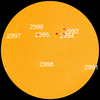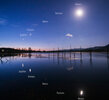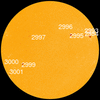SOLAR CYCLE 25 ACTIVITY REPORT APR 21
▪︎Latest Solar wind speed record: 444.1 km/sec
▪︎density: 6.4 protons/cm3
▪︎Sunspot number: 80 (SN 68 apr 20)
▪︎ Neutron Counts today: +7.7% High
▪︎Geomagnetic conditions now Kp2 quiet
▪︎Strong M9.73 solar flare from AR2993
▪︎Sunspot complex AR2993-94 poses a threat for X-class solar flares.
▪19 Sunspots in AR2993, 8 Sunspots in AR2994. The sunspots have a magnetic classification beta-gamma more likely to produce intense flares.
▪︎There were 9 CME yesterday
▪︎Solar Cycle 25 vs Solar Cycle 24
▪︎complex AR2993-94 like a Solar City
▪︎Latest Solar wind speed record: 444.1 km/sec
▪︎density: 6.4 protons/cm3
▪︎Sunspot number: 80 (SN 68 apr 20)
▪︎ Neutron Counts today: +7.7% High
▪︎Geomagnetic conditions now Kp2 quiet
▪︎Strong M9.73 solar flare from AR2993
▪︎Sunspot complex AR2993-94 poses a threat for X-class solar flares.
▪19 Sunspots in AR2993, 8 Sunspots in AR2994. The sunspots have a magnetic classification beta-gamma more likely to produce intense flares.
The different classifications
- α – Alpha:
A unipolar sunspot group.- β – Beta:
A sunspot group that has a positive and a negative polarity (or bipolar) with a simple division between the polarities.- γ – Gamma:
A complex region in which the positive and negative polarities are so irregularly distributed that they can’t be classified as a bipolar Sunspot group.- β-γ – Beta-Gamma:
A bipolar sunspot group but complex enough so that no line can be drawn between spots of opposite polarity.- δ – Delta:
The umbrae of opposite polarity in a single penumbra.- β-δ – Beta-Delta:
A sunspot group with a general beta magnetic configuration but contains one (or more) delta sunspots.- β-γ-δ – Beta-Gamma-Delta:
A sunspot group with a beta-gamma magnetic configuration but contains one (or more) delta sunspots.- γ-δ – Gamma-Delta
A sunspot group with a gamma magnetic configuration but contains one (or more) delta sunspots.
StackPathMore than half of the observed sunspot groups receive an Alpha or Beta classification, where bigger sunspots are often more complex and get a Beta, Beta-Gamma or Beta-Gamma-Delta classification. It is well known that delta sunspots can be very active and produce the most intense solar flares.
▪︎There were 9 CME yesterday
CME WATCH: With all the large flares, perhaps it is not surprising that we have a lot of spectacularly beautiful coronal mass ejections tonight. There are at least 6 in this 2-day movie, most of them off the SW limb probably from the region that just rotated over the limb, AR2992
▪︎Solar Cycle 25 vs Solar Cycle 24
The total number of SC25 CMEs are outpacing those of SC24 at the same stage of the cycle by ~30%. For the first 18 months of both cycles the numbers were indistinguishable but since then SC25 has been pulling away significantly. If reflected in solar maximum the peak would be 150
▪︎complex AR2993-94 like a Solar City






 happy weekend
happy weekend





